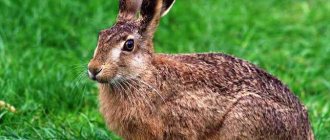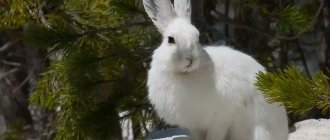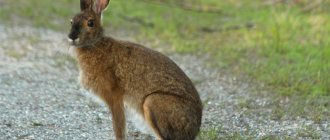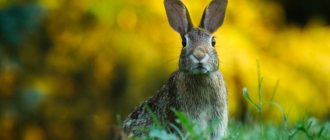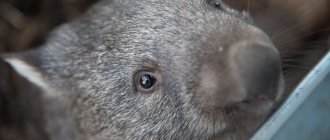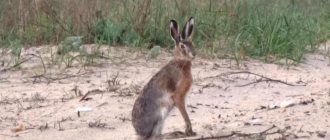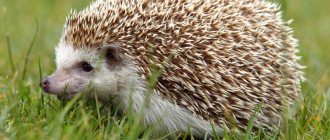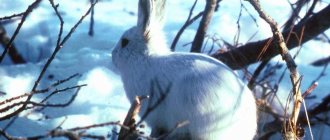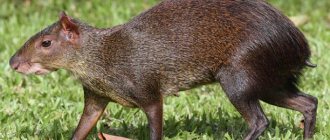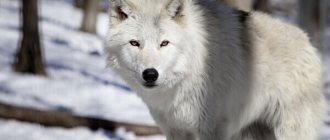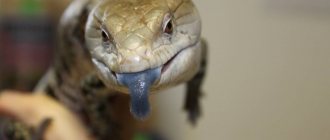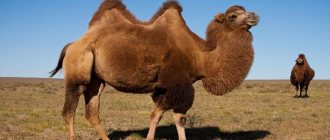The hare is one of the most common and famous animals in Russia. Men go hunting for him, women wear clothes with hare fur, and children watch cartoons and read fairy tales about the jumping bunny. But what exactly is this animal?
In lessons about the surrounding world, schoolchildren get acquainted with various species of this animal, learn the features of appearance by looking at pictures, differences in habits and adaptability to nature and habitat, and learn ways to prepare hares for autumn and winter. Some people, especially in villages, keep rabbits as pets. Information on how to care for animals so that they produce healthy offspring is very important and interesting.
Hare: description and characteristics
Hares represent the animal kingdom and belong to the family Lagoraceae, which belongs to the order Lagomorpha. This order includes not only the familiar hares and rabbits, but also, for example, pikas. They are distinguished from other species primarily by long ears, strong legs that allow them to move quickly and jump long distances, and a short tail.
Appearance
Hares are relatively small animals. Adults can reach 60 cm in length and weigh up to 7 kg. They are not distinguished by large muscle mass, they have a long body that seems to be flattened on the sides. The main distinguishing feature is large, long ears, which are approximately the same size as the length of the head. In some species, the ears are pointed, while in others, on the contrary, they are rounded at the top.
Hares have a small head relative to their entire body. Another distinctive feature of these animals is the special shape of their lips: the upper lip is divided into two parts by a small groove.
The teeth of these mammals are incredibly sharp and grow throughout their lives. Because of this, hares always need solid food to help wear down their growing incisors.
The structure of the teeth of hares is very similar to the teeth of rodents. They differ only in an additional pair of incisors. For this reason, many people mistakenly classify hares as members of the rodent family, which is incorrect.
The front and hind legs of hares have different lengths. In most species, the forelimbs are several times shorter than the hind limbs. The heels of the hind legs are covered with hair and sharp claws. Their presence helps them hide from predators and quickly break through the snow in winter to get food. The difference in paw length is also explained by their lifestyle: hares are prey for many predators, and their long hind legs allow them to move quickly in times of danger.
Hare eats grass
Types of hares
The genus of hares consists of a dozen subgenera, each of which is divided into species.
White hare
White hare (Latin: Lepus timidus). Body length is about 44-65 cm; weight 1.6-4.5 kg. A distinctive feature of this white hare is its ability to masterfully camouflage itself. The hare has a white fur color in winter; in summer the fur becomes gray. The white hare is the target of many sport hunters. Habitat: Russia (including the Arctic); China, Mongolia, northern Europe, South America.
Brown hare
Brown hare (Latin: Lepus europaeus). The largest representative of lagomorphs, has brown fur. The body length is 68 cm, weight up to seven kilograms. The fur shines and curls a little. The tail and ears are larger than those of the hare. The hare, one might say, is a steppe hare. Habitat: Europe, Kazakhstan, Turkey, Transcaucasia, Arabian Peninsula, North Africa.
Antelope hare
Antelope hare (Latin: Lepus alleni). The body length is 45-60 cm. A distinctive feature of the antelope hare is its impressively sized ears, up to 20 cm. They help normalize the animal’s heat exchange in hot climates. This species lives in northwestern Mexico and American Arizona.
Chinese hare
The Chinese hare (Latin: Lepus sinensis) is distinguished by its miniature size. The body length is 30-45 cm, weight is within 2 kg. Fur color varies from chestnut to red. The coat is short and harsh in texture. Habitat: China, Taiwan and Vietnam; inhabits mainly elevated areas.
Tolai hare
Tolai hare (Latin: Lepus tolai). Outwardly it has similar features to the hare, only noticeably more compact in size. Body length 39-55 cm, weight 1.5-2.8 kg. The fat hare's limbs and ears are larger than those of the brown hare. Lives in Central Asia, Kazakhstan, Northeast China and Mongolia. Almost everywhere in Russia.
Yellowish hare
Yellowish hare (Latin: Lepus flavigularis). Body length 60 cm, weight 4 kg. The ears and legs are large. The yellowish hare has an original ear color. From their base to the back of the head there are two black stripes, the sides are white. Hare's habitat: the coast of the Gulf of Tehuantepec in Mexico. Terrain: Coastal grassy dunes and open grasslands. Stays awake in the dark.
Broom hare
Broom hare (Latin: Lepus castroviejoi). The body length of a hare of this species is 45-65 cm, weight is from 2.6 to 3.2 kg. The color of the hare is black-brown, with small white patches. It lives in Spain and is listed in the Red Book of this country. The species is widespread in areas with little vegetation. In many characteristics, the broom hare is similar to the brown hare.
Black-tailed hare
Black-tailed (California) hare (Latin: Lepus californicus). Body length 47-63 cm, weight 1.5-3 kg. A distinctive feature of the species is its long ears and massive hind legs. The fur on the upper part of the body is gray-brown in color. The back of the animal is decorated with a black stripe. The population of these lagomorphs is most impressive in the western United States and Mexico. The black-tailed hare is a loner.
Manchurian hare
Manchurian hare (Latin: Lepus mandshuricus). The body size of the Manchurian hare is 40-55 cm, weight 1.3-2.5 kg. The legs, tail and ears are relatively short, which gives the Manchurian hare similar features to the wild (European) rabbit. The fur is hard and bristly. The color of the coat is brown, uneven, with gray patches. Along the back there is a dark stripe of longer hair. It is found in the south of the Russian Far East, in the Chinese region of Manchuria and in the north of Korea. We can say that this is a forest hare, preferring deciduous forests with dense bushes.
Tibetan curly hare
Tibetan curly hare (Latin: Lepus oiostolus). The body length is 40-58 cm. Weight is 2.3 kg. The fur of this animal has a yellowish tint, and the fur on the back is slightly wavy. Habitat: China, India, Nepal. Terrain: highlands of Tibet.
South American golden hare
Agouti (Latin: Dasyprocta) or South American golden hare (humpback hare). This animal belongs to the order of rodents and is a relative of guinea pigs. Agouti is also popularly called the golden (or golden) hare. This animal has a body length of 50 cm and weighs about 4 kg. It received its second name due to its golden color. The humpback hare is widespread in Central and South America, from Mexico to Brazil. Agoutis are very good swimmers.
domestic hare
The hare, unlike the rabbit, which is a burrowing animal, needs space and a lot of movement. If desired, hares can be bred at home, following certain rules.
Features of keeping a hare at home:
- The hare needs a spacious cage or enclosure.
- Walking around the apartment. Until the age of 1 month under close supervision, from 1 month free walking.
- The hare must be vaccinated and dewormed.
- The little bunny should be immediately taught to go to the toilet; diapers or dry grass should be used as litter for the tray. Granular litter cannot be used.
Hares are very sociable animals, living in an apartment, they require constant interaction with humans, games, and attention. But these animals should not be held in your arms all the time; they do not like hugs.
Features of feeding a hare at home:
- Hare's milk is very fatty in composition, up to 20%, so it is impossible to feed a hare with cow's milk or human infant formula. It is recommended to give bitch and cat milk substitutes every 3-4 hours.
- You cannot sweeten milk for rabbits.
- From the age of two weeks, in addition to milk, you need to give green grass, leaves and twigs.
- From one and a half months, it is necessary to completely switch the teenager to solid food: green grass, twigs, berries, fruits.
- From two months of age, add grain-free ready-made food to the hare's diet.
By following all the recommendations, the wild animal will take root in a human home and become a full member of the family. A funny pet hare can become a friend for children.
You cannot release an already tamed hare into the wild; it will not survive.
Giant Rabbit (Flanders)
One of the most amazing representatives of lagomorphs is the Flanders, or Belgian giant. This is an industrial breed of rabbits. The body length of adult individuals is 67 cm, weight 7-10 kg. The coat is thick, the color is hare-gray, yellow-gray, dark gray, iron-gray. The breed began to be bred in 1952.
Sea hare seal
The bearded seal, or bearded seal, belongs to the family of true seals. The body length is 2.5 meters. In winter, the weight is 360 kg. The bearded seal lives in the shallow waters of the Arctic Ocean and adjacent waters of the Atlantic and Pacific oceans. Representatives of northern peoples make household items from seal skin. The pregnancy of a female sea hare lasts a year, one calf is born, with a body length of 120 cm. The ability to reproduce appears at the age of five years.
Where does the hare live?
Hares live exclusively on land. They cannot swim or climb trees. Some species prefer to live in the steppes and open areas, while others, on the contrary, live in the forest, where there are many trees and bushes. This is largely due to the presence or absence of predators; it is easier to hide from them in the forest. For example, the hare prefers the tundra and dense forests and rarely goes to other places.
The northern regions of our planet are considered the historical homeland of hares: the north of Eurasia and North America. However, today hares have been introduced by humans to all corners of the planet and are found on all continents with the exception of Antarctica.
Interaction with relatives also occurs in different ways: some species lead a solitary lifestyle and prefer solitude, while others can gather in flocks.
Elena
Ask a Question
Question to the expert
Is it true that it is dangerous to touch a wild hare in the forest?
Yes. Hares defend themselves using their hind legs and claws and can cause damage to a person's hands, such as hitting veins or even breaking bones.
Surge
Another type of hunting for this animal is drive. It is used when the hare gets out of their bed. In this case, the shooters, hiding, go forward, and at this time several beaters walk along the slope and drive the animal towards them. Please note that at this time you can also come across foxes in the ravine.
People go along the so-called white trail to hunt hare, emerging from hiding places. The ambush is set up in places where hares feed - these are haystacks, winter fields, vegetable gardens and orchards on the edge of the village. In this case, you should wear a camouflage suit over warm outerwear, and equip the ambush site with a support for your back, since you will have to sit in this position for up to several hours. Clear moonlit nights are considered ideal conditions for such hunting. In order not to get wounded, use devices for precise aiming, for example, a headlight or an under-barrel flashlight.
How many years does a wild hare live?
Recommended by topic
Fox Panda Lynx
The lifespan of hares is influenced by many factors, such as lifestyle, gender and habitat. Males usually live from 5 to 7 years, females - 9-10 years. Hares tamed by humans live longer.
Color also plays a big role in life expectancy. For example, a white hare that skillfully uses camouflage can live more than 10 years. Scientists know of cases where such a hare lived for 17 years, but this is the exception rather than the rule.
Browns live on average 5-6 years, rarely 10 years. The American hare lives on average up to 8 years. But as a rule, most species do not live up to these values, as they become victims of predators.
arboreal climber
Lives only in the Ryukko archipelago and nowhere else. This is a descendant of an ancient family that lived on the planet more than 20 million years ago.
You can find different names for it. One of the most common is Amami, after the island in the Sea of Japan where they live. In Japan itself it is often called the Japanese rabbit.
These cute creatures have soft fur, short ears and a tail. It does not build nests, but digs holes in which it spends daylight hours. The search for food occurs at night. Thus, he is still saved from natural enemies.
Don't miss the fascinating material on our website most-beauty.ru about 15 animals that can only be found in certain places.
12
Lifestyle
Hares are exclusively land animals. Most species flock together and live together in burrows. Regardless of their habitat, hares are active throughout the year and do not hibernate in winter.
They prefer to forage for food at night. During the day they hide in burrows or in dense thickets, hiding from large predators. In winter they can hide in the snow, making deep burrows in the snowdrifts. The speed of a hare when moving can reach 60 km/h, which is ensured by strong hind legs and long jumps.
Question to the expert
Is it possible to bring a wild hare home?
It’s better not to, it’s a lot of stress for the animal, and it can behave aggressively. If you find a wounded or exhausted hare somewhere, it is better to take it to a veterinary clinic, where professionals will take care of it.
These animals do not have good eyesight, but they are endowed by nature with acute hearing and sense of smell. This helps them sense approaching danger and react quickly. They prefer to sit in shelters for a long time and leave it only in case of insurmountable danger. The stereotype that hares are cowardly has developed precisely because of their defensive tactics. When they sense danger, they quickly jump out of their hiding place and run away. This often saves lives.
When running away from a predator, the hare does its best to confuse its tracks: it changes direction, jumps long distances in different directions and in the opposite direction. Catching a healthy and young hare is a great success for a predator.
But hares are not at all as cowardly as they might seem: if this animal feels that it cannot escape from a predator, then another tactic comes into play. The hares lie on their backs and begin to hit the attacker with their hind paws, as if brushing them off. Their blows are quite strong due to their muscles and sharp claws. Often, after such an encounter, predators retreat or suffer fatal injuries. Those who are keen on hunting know that it is better not to take a still living hare by the ears. Even a person can get injured from being hit by their hind legs.
Hunting with a self-propelled gun
Before the snow falls, hare hunting is called self-hunting. During these months, the hare lies as tightly as possible, so it is better to go hunting in the company of three or four of them.
From the outside it may seem that hunters are wandering through plowed land or stubble without any purpose, exploring tall weeds, or descending into ravines. In reality, they are trying to look out where the hare is most likely to be. Such hunting in the autumn is extremely exciting.
When the hunter stands directly on the scythe's bed, the hare is sure to blow himself up. To make it even easier to excite him, you should just walk at a leisurely pace and stop as often as possible. In this case, the hare may think that he has been noticed, he explodes and begins to run away.
Interestingly, hunting with a self-propelled gun has a universal feature. Having raised the very first hare, you need to very carefully explore the entire area in the area. Often it is possible to raise a few more birds nearby.
This method of hunting requires the hunter to have a thorough knowledge of the animal’s habits. For example, if it rained the previous night, then you should not look for the hares’ hiding places in the bushes or under the trees, since the drops falling from the branches greatly disturb him. It is better to go to a meadow or field.
In late autumn and early winter, brown hares often feed on winter crops. Walking along their edges, you can find hare nests.
Nutrition
The food of hares consists mainly of plant solid food, for which their jaws are adapted. This can be grass, tree bark, young shoots and flowers. For example, species living in central and eastern Europe prefer clover and dandelions.
Often, hares become a problem for gardeners, gnawing the bark on young cultivated plants, eating beds with carrots or cabbage.
In winter, hares feed on tree bark, as well as plants preserved under the snow. They get them with the help of powerful paws, which allow them to quickly get food from under the snow.
For example, let’s present the diet of some species in the form of a table:
Brown hare
| Season | Diet |
| Spring | Fresh grass |
| Summer | All kinds of plants: tree bark, bush shoots, berries |
| Autumn | Preserved fruits of summer plants, late autumn stems and bark |
| Winter | Tree bark, seeds, shoots and fruits of plants preserved under the snow |
The hare's enemies
In their natural habitat, hares have a large number of enemies. The main predators are foxes and wolves. But this does not mean that the hare is doomed to death. He has speed and agility on his side, making him virtually elusive to predators. The clutches of wolves and foxes usually fall into either old or sick animals that cannot escape quickly. Catching a young hare costs predators a lot of work.
Hares are often attacked by birds of prey, but for adult representatives of the species they are practically safe.
How do hares escape from predators?
Recommended by topic
Meerkat Swift Jerboa
Also, the population of hares remains at a high level due to their ability to repel predators. They can defend themselves against attacks in the following ways:
- Claws and paws . As already mentioned, hares have incredibly powerful hind legs and sharp claws. Not every predator can cope with this. There have been cases when a hare, with the help of its claws, tore the belly of an attacking fox. In a similar way, they protect themselves from birds: when a predator approaches from above, the hare delivers a blow, which, if it does not kill, will at least temporarily incapacitate the bird.
- Teeth . Since hares prefer tough plant foods, they have incredibly sharp and strong teeth. In case of attack, the hare defends itself with the help of them. Of course, it is unlikely that you will be able to cope with large predators, but it is quite possible to break the wing or paw of an attacking bird.
- Speed . But, of course, the main advantage of the oblique is its speed. In its incredible turns, it can accelerate to 60 km/h. Not every predator is able to withstand such speed.
Sandstone or tolai
The tolai hare is not large, weighing a maximum of about 3 kg. Body length up to half a meter. Found in the regions of Altai, Transbaikalia, and Southern Siberia. Prefers to settle in bush thickets near rivers, mountain meadows and open desert areas. The desert hare has paws that are not suitable for moving through deep snowdrifts, so when snow falls, it descends to the foot of the mountains. Its summer color is gray with small variegated shading, and in winter it is a little lighter.
The tracks of the tolai are similar to the tracks of the hare, but much smaller. However, experienced hunters are able to distinguish these two species not only by their tracks, but also by the way they move, from afar.
Reproduction
Despite their vulnerability, the population of hares around the world is not of concern to scientists. It's all about their ability to quickly reproduce offspring. As a rule, a female and a male form a pair and stay together, but there are exceptions.
On average, about 50 days pass from the moment of conception to birth. At one time, a female can reproduce up to 10 cubs. Unlike other animals, rabbits are immediately born with fur, and from the first minutes of life they can see and move independently. In the first few days, the cubs need milk, and then they switch to plant foods. Hares reach sexual maturity at 7 months.
Black-brown
An amazing creature from the hare family lives on Espiritu Santo in the Gulf of Mexico. It is also found on mainland Mexico.
It received its specific name because of its original coat color. It lives in open spaces, and its main diet consists of shoots of bushes. They enjoy eating some types of cacti. They build open nests in which they stay during the day, but are mainly nocturnal.
The female bears offspring, and after a couple of days the hares are ready for independent life. But the female continues to take care of the offspring when the little hares explore new territories.
?
How do hares spend the winter?
Seasonal climate changes have a significant impact on all animals, and hares are no exception. Unlike other animals, hares do not hibernate, so they are forced to adapt to their surrounding conditions.
First of all, it is worth noting that winter is a fairly favorable time for hares from a safety point of view. They easily change the color of their skin to white, which camouflages them well against the background of snow. Therefore, during the day, hares are usually passive and spend all their time in shelters, without fear of being caught.
In the evening, hares always go out to get their own food. This is risky, but at night they are also invisible to predators due to the darkness.
As for preparing for winter, hares are passive here too. They have no need to build a permanent burrow or store food. They can cope with all this perfectly well without it: tree bark is available at any time of the year, and white wool is thicker and protects well from the cold.
In winter, especially at the beginning, hares often go out into agricultural fields and eat up winter crops, which can cause harm to humans.
Burmese
The wild Burmese hare is found in the countries of the Indochina Peninsula. On the island of Con Dao it was seen at an altitude of 1,200 m above sea level.
It roosts in bush thickets and grazes in open meadows rich in lush grass. During the day it prefers to sit in a shelter, and at dusk it leaves its shelter to find food. Like other members of the family, it has many natural enemies.
Its belly is white, but its back and sides are gray with an orange tint. This is a small species, since the length does not exceed 50 cm. In times of danger, if it was not possible to hide, it presses its ears to the body and presses itself to the ground.
4
Population and conservation status
The population of hares around the world does not cause concern among scientists. According to the international classification, they are assigned the status of “LC”, which indicates that the extinction of this species is unlikely. All thanks to the fact that one female can give birth 4 times a year. In addition, hares are quite unpretentious and can learn to live in any area, which proves their presence on all continents.
But despite this, there are certain species of hares that are endangered:
- White-sided hare;
- Yellowish hare;
- Ethiopian hare.
Also among the hares there is a completely extinct species, the Don Hare, which previously lived in Eastern Europe and is a relative of the white hare.
Hares also receive a lot of damage from humans. They often become objects of amateur hunting and are also of great commercial importance.
Hares color
The color of a hare is directly related to the season. In summer, its coat can be brown, reddish-gray, or brown. The color of the animal is uneven, since the fluff under the fur has a dark shade. There are also small inclusions. The fur on a hare's belly is always white. In winter, the fur of the fluffy animal becomes lighter, but only the white hare’s is impeccably white. The tips of the ears of lagomorphs are black all year round.
Commercial significance
Despite their small size, hares have always been significant for humans and are still considered valuable animals. Here are some reasons:
- Dietary meat . Lean and tasty meat is considered a delicacy.
- Warm fur, especially in winter . Winter clothes are made from the skins of hares.
- Hunting . Hares are one of the most popular animals among amateur hunters.
Interesting facts about hares
- Hares communicate with each other by beating their paws, as if playing drums.
- Despite the fact that hares prefer plant foods, they can often feast on other animals, such as birds. Moreover, their paws do an excellent job of cutting up a carcass.
- Hares are one of the few that can survive a “second pregnancy.” Conception can occur already at the moment when there is another fetus in the womb.
- The hind legs of hares are always different from each other.
- By touching plants with their noses, hares inform their relatives of their arrival.
- Historians claim that hares were domesticated by humans immediately after cats and dogs.
- The burrows of hares resemble apartments. As a rule, they dig out large areas with corridors and separate “rooms”.
- The largest representative of the species lived on the planet about 12 million years ago and weighed up to 15 kg.
- Hares are very smart and quick-witted, despite their small brains.
- During the breeding season, females can feed milk not only to their own hares, but also to others who are left without parents or simply meet the hare along the way.
Antelope
One of the largest species in the genus of hares. Long ears reach 16.5 cm. The hearing organs are completely hairless. There are only small patches of white fur along the edges and at the tip.
All the hair on the body is gray with black tips. The back is slightly darker than the rest of the body. The nose has small whiskers. He lives in North and Central America in a hot zone, and therefore has learned to easily cope with the heat. Animal fur has reflective properties.
Latin name Alleni. It is named after the American zoologist, head of the mammal department of the New York Museum, Joel Allen.
10
